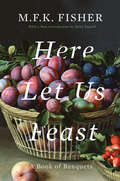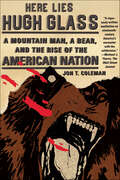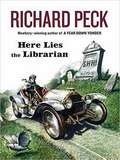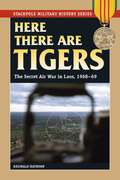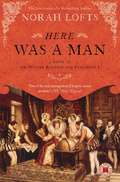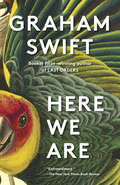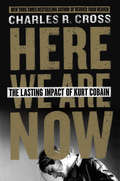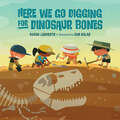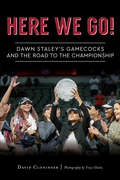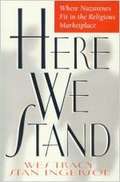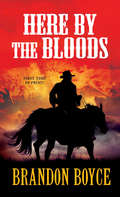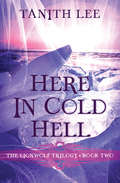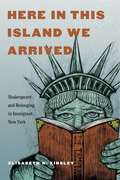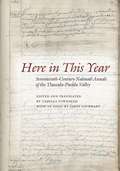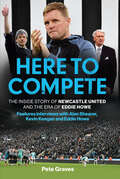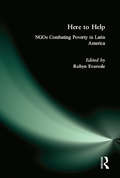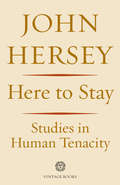- Table View
- List View
Here Let Us Feast: A Book of Banquets
by M. F. Fisher"M.F.K Fisher’s latest excursion into the art or science of gastronomy is more an anthology of the finest writing on the subject than strictly a text of her own composition . . . A royal feast, indeed!" —The New York TimesBetty Fussell—winner of the James Beard Foundation’s journalism award, and whose essays on food, travel, and the arts have appeared in The New York Times, The New Yorker, Saveur, and Vogue—is the perfect writer to introduce M.F.K Fisher’s Here Let Us Feast, first published in 1946. The author of Eat, Live, Love, Die has penned a brilliant introduction to this fabulous anthology of gastronomic writing, selected and with commentary from the inimitable M.F.K. Fisher.The celebrated author of such books as The Art of Eating, The Cooking of Provincial France, and With Bold Knife and Fork, Fisher knows how to prepare a feast of reading as no other. Excerpting descriptions of bountiful meals from classic works of British and American literature, Fisher weaves them into a profound discussion of feasting.She also traces gluttony through the Old and New Testaments of the Bible, and claims that the story of a nation's life is charted by its gastronomy. M.F.K. Fisher has arranged everything perfectly, and the result is a succession of unforgettable courses that will entice the most reluctant epicure.
Here Lies Hugh Glass: A Mountain Man, a Bear, and the Rise of the American Nation
by Jon T. ColemanIn the summer of 1823, a grizzly bear mauled Hugh Glass. The animal ripped the trapper up, carving huge hunks from his body. Glass's fellows rushed to his aid and slew the bear, but Glass's injuries mocked their first aid. The expedition leader arranged for his funeral: two men would stay behind to bury the corpse when it finally stopped gurgling; the rest would move on. Alone in Indian country, the caretakers quickly lost their nerve. They fled, taking Glass's gun, knife, and ammunition with them. But Glass wouldn't die. He began crawling toward Fort Kiowa, hundreds of miles to the east, and as his speed picked up, so did his ire. The bastards who took his gear and left him to rot were going to pay.Here Lies Hugh Glass springs from this legend. The acclaimed historian Jon T. Coleman delves into the accounts left by Glass's contemporaries and the mythologizers who used his story to advance their literary and filmmaking careers. A spectacle of grit in the face of overwhelming odds, Glass sold copy and tickets. But he did much more. Through him, the grievances and frustrations of hired hunters in the early American West and the natural world they traversed and explored bled into the narrative of the nation. A marginal player who nonetheless sheds light on the terrifying drama of life on the frontier, Glass endures as a consummate survivor and a complex example of American manhood. Here Lies Hugh Glass, a vivid, often humorous portrait of a young nation and its growing pains, is a Western history like no other.
Here Lies the Librarian
by Richard PeckPeewee idolizes Jake, a big brother whose dreams of auto mechanic glory are fueled by the hard road coming to link their Indiana town and futures with the twentieth century. And motoring down the road comes Irene Ridpath, a young librarian with plans to astonish them all and turn Peewee’s life upside down. Here Lies the Librarian, with its quirky characters, folksy setting, classic cars, and hilariously larger-than-life moments, is vintage Richard Peck-an offbeat, deliciously wicked comedy that is also unexpectedly moving. .
Here Lies: An Autobiography
by Eric AmblerIn his Edgar Award–winning autobiography, the “father of the modern crime thriller” reveals the eventful life that inspired his classic works (CrimeReads).Eric Ambler’s Here Lies invites readers inside the mind of one of the twentieth century’s greatest thriller writers. In this work the famously recalcitrant author peels back the layers of experience that affected his life with the same skill he uses to unfold the plots of his novels.Ambler candidly describes his South London childhood; his brief engineering career, which he gave up to work in theater; and his time as an advertising copywriter. He details the publication of his revolutionary spy novels in the 1930s and ’40s, including such early classics as A Coffin for Dimitrios and Journey into Fear. He also tells of his service in the film division of the British War Office during World War II, which allowed him to write his first screenplays; and his postwar renown as the leading writer in the genre on both sides of the Atlantic.
Here There are Tigers (Stackpole Military History Series)
by Reginald HathornIn-the-cockpit perspective on aerial warfare during the Vietnam War. Many never-before-heard stories--some of them tragic, others humorous.
Here Was a Man
by Norah LoftsIn one of her earliest works, beloved author Norah Lofts brings us her riveting and romantic account of Sir Walter Raleigh and the court of Elizabeth I. Raleigh knew from the time he was a boy that his life would be exceptional. He dreams of someday exploring the New World he's heard about in snippets of sailors' stories on the docks of the fishing villages where he was raised; and his good fortune leads him to rise in the court of Elizabeth I, becoming a most trusted friend and advisor to the power players of the day. Raleigh's wit, ambition, and adventurous spirit endear him to all, including the queen herself, but Elizabeth's favor proves as much hindrance as help, as Raleigh still has but one goal in mind -- to take to the seas and secure his place as one of the great explorers of the age. The queen will not allow her young knight to be taken from her side, repeatedly refusing his requests for expeditions, until she at last reluctantly grants him permission to conquer in her name. Meanwhile, between journeys, his passion is stirred, not by the queen but by her lady-in-waiting Lisbeth. His loyalties are split between the boundless opportunities the queen can bestow and the pull of his own heart. With cameo appearances by Shakespeare, Marlowe, Sydney, and other luminaries of the day, Lofts once again paints a colorful, nuanced, and moving portrait of the Elizabethan Age. Here Was a Manis another timeless classic from the legendary Norah Lofts.
Here We Are
by Graham SwiftOne of the best writers at work today, author of the internationally acclaimed Mothering Sunday, brings us another superbly conceived novel that, with astonishing economy, touches depths and evokes wonders--not least because its central theme is magic.In the summer of 1959, at the pier theatre in Brighton, England, a variety show unfurls every night, held together by Jack Robinson, its master of ceremonies. At 28, already a veteran of the stage, he introduces the performers with some showmanship of his own, and he knows how to send the audience home happy. But the true stars of the evening are Pablo and Eve. "Pablo" is really Ronnie, a magician who prefers to be called an "illusionist," Jack's friend from army days; "Eve" is Evie, Pablo's "delightful, delicious, delorable" assistant. Through the summer season, their act shifts from mere stock trickery to truly unfathomable wizardry, with Jack providing the encouragement they need on stage--and the personal entanglement none of them saw coming. As the novel explores the essential experiences of their lives--apart and together, past and present and deep into their old age--we understand their enduring inseparability, bound together by a mix of truth and deception to which they all contribute. Here We Are is both hauntingly moving and vividly comic. A love story involving more than one love, a vision of the world lingering at the edge of change and emerging slowly from the aftermath of war, it dazzles with Swift's own ability to conjure in a brief space the complexities, mysteries and moments of living magic at the heart of existence itself.
Here We Are Now: The Lasting Impact of Kurt Cobain
by Charles R. CrossIn Here We Are Now: The Lasting Impact of Kurt Cobain, Charles R. Cross, author of the New York Times bestselling Cobain biography Heavier Than Heaven, examines the legacy of the Nirvana front man and takes on the question: why does Kurt Cobain still matter so much, 20 years after his death?Kurt Cobain is the icon born of the 90s, a man whose legacy continues to influence pop culture and music. Cross explores the impact Cobain has had on music, fashion, film, and culture, and attempts to explain his lasting and looming legacy.
Here We Are: A novel (Vintage International Ser.)
by Graham SwiftIn his newest novel, acclaimed author Graham Swift marries the erratic devastations of reality with the elusive probability of magic under the lights of vaudeville, a story of delicate illusions where what one chooses to believe can unearth the most revealing connections.It's the summer of 1959, and something magical can be witnessed at the end of the pier in beach town Brighton, England. Jack Robbins, Ronnie Deane, and Evie White are performing in a seaside variety show, starring as Jack Robinson the compere comedian, and The Great Pablo and Eve: a magic act. By the end of the summer, Evie's glinting engagement ring will be flung to the bottom of the ocean and one of the trifecta will vanish forever. All three friends begin their path toward the end of Brighton's pier early in life. Evie and Jack's mothers always trumpeting the support that is trademark of stage mothers, while Ronnie's mother sends her son out in the child evacuations to Penny and Eric Lawrence for safety from the London blitz. It's within the safety and love of Evergrene, the Lawrences' estate, that magic creeps into Ronnie's life for the first time and starts the intricate intertwining of fate, chance, and show business. Magic and reality share the stage in this masterly and devastating story that pulls back the curtain on the power of love, family, and the touchstones of our memories.
Here We Go Digging for Dinosaur Bones
by Susan Lendroth"This is a perfect book for a dinosaur storytime." —School Library JournalThis STEM-friendly musical fossil dig will have dinosaur lovers singing along as they learn the science behind paleontology.Set to the tune of "Here We Go 'Round the Mulberry Bush," Here We Go Digging for Dinosaur Bones invites budding paleontologists and dinosaur fans on an exciting fossil dig. Readers will hike the trail, scan the ground, and make a find—then discover how to build a T. Rex from its bones.
Here We Go: Dawn Staley’s Gamecocks and the Road to the National Championship (Sports)
by David CloningerShe stood at the podium on May 10, 2008, and promised to bring national prominence to South Carolina. Most thought it would take a miracle to get to that point, but Dawn Staley has always beaten the odds. Staley’s vision for the Gamecocks’ women’s basketball team came true over the next nine years, culminating in the 2017 national championship. Her willingness to keep striving—to deliver on her promise—was met with early resistance. It paid off with several winning seasons, then terrific recruits. And, finally, the only prize Staley had not obtained in a lifetime of championship basketball. David Cloninger takes you on the team’s journey to the national title.
Here We Stand: Where Nazarenes Fit In The Religious Marketplace
by Wesley Tracy Stan IngersolBelieve anything you want. The twentieth century has brought with it a myriad of opinions, philosophies, doctrines and ideologies. Each one of them important; each one valid. And the world says, 'Believe what you want. 'Authors Wes Tracy and Stan Ingersol have authored Here We Stand to shatter that conclusion. More than ever, it is important that we know what we believe. Here We Stand is a comprehensive study of a wide range of beliefs and where Nazarenes fit into the ideological puzzle. Tracy and Ingersol provide the most contemporary and complete overview of major religions and religious beliefs since Why I Am a Nazarene. Nazarenes have the unique opportunity to reestablish their identity with a new generation of people. Here We Stand gives a clear view into other traditions in a language and approach understood by today's pastors and laymen. Here We Stand contributes to the distinctiveness of each group without sacrificing the Christian community as a whole. Pastors, Sunday School teachers and new Christians will find this unabridged version of the book What Is a Nazarene? an excellent resource because it lends a knowledgeable, objective voice to discussions of doctrine, witnessing and spirituality. Here We Stand provides the historical and theological background needed to establish identity and ownership among new and life-long Nazarenes. Kivar.
Here and Everywhere Else: Small-Town Maine and the World
by Andrew WitmerWinner of an Award of Excellence, American Association for State and Local History (AASLH) In 1822, settlers pushed north from Massachusetts and other parts of New England into Monson, Maine. On land taken from the Penobscot people, they established prosperous farms and businesses. Focusing on the microhistory of this village, Andrew Witmer reveals the sometimes surprising ways that this small New England town engaged with the wider world across the nineteenth and twentieth centuries. Townspeople fought and died in distant wars, transformed the economy and landscape with quarries and mills, and used railroads, highways, print, and new technologies to forge connections with the rest of the nation.Here and Everywhere Else starts with Monson’s incorporation in the early nineteenth century, when central Maine was considered the northern frontier and over 90 percent of Americans still lived in rural areas; it ends with present-day attempts to revive this declining Maine town into an artists’ colony. Engagingly written, with colorful portraits of local characters and landmarks, this study illustrates how the residents of this remote place have remade their town by integrating (and resisting) external influences.
Here and Then
by George Ella LyonThrough ghostly visitations and a diary that seems mysteriously to write itself with twelve-year-old Abby's hands, a Civil War nurse asks for help with medical supplies across an abyss of 133 years. Abby and Harper gather the supplies. Then Abby makes a dangerous delivery. [from the back cover] "Abby thought playing the part of a nurse named Eliza Hoskins in her parents' Civil War reenactment group might be fun. She even decided to write in her diary about the experience. What she didn't count on was that Eliza would begin to take over the diary--and her life." Ages 8-12.
Here and There: Reading Pennsylvania's Working Landscapes
by Bill ConlogueThe global economy threatens the uniqueness of places, people, and experiences. In Here and There, Bill Conlogue tests the assumption that literature and local places matter less and less in a world that economists describe as “flat,” politicians believe has “globalized,” and social scientists imagine as a “global village.” Each chapter begins at home, journeys elsewhere, and returns to the author’s native and chosen region, northeastern Pennsylvania. Through the prisms of literature and history, the book explores tensions and conflicts within the region created by national and global demand for its resources: fertile farmland, forest products, anthracite coal, and college-educated young people. Making connections between local and global environmental issues, Here and There uses the Pennsylvania watersheds of urban Lackawanna and rural Lackawaxen to highlight the importance of understanding and protecting the places we call home.
Here and There: Reading Pennsylvania's Working Landscapes
by Bill ConlogueThe global economy threatens the uniqueness of places, people, and experiences. In Here and There, Bill Conlogue tests the assumption that literature and local places matter less and less in a world that economists describe as “flat,” politicians believe has “globalized,” and social scientists imagine as a “global village.” Each chapter begins at home, journeys elsewhere, and returns to the author’s native and chosen region, northeastern Pennsylvania. Through the prisms of literature and history, the book explores tensions and conflicts within the region created by national and global demand for its resources: fertile farmland, forest products, anthracite coal, and college-educated young people. Making connections between local and global environmental issues, Here and There uses the Pennsylvania watersheds of urban Lackawanna and rural Lackawaxen to highlight the importance of understanding and protecting the places we call home.
Here and There: Sites of Philosophy
by Stanley CavellThe first posthumous collection from the writings of Stanley Cavell, shedding new light on the distinctive vision and intellectual trajectory of an influential American philosopher. For Stanley Cavell, philosophy was a matter of responding to the voices of others. Throughout his career, he articulated the belief that words spring to life in concrete circumstances of speech: the significance and power of language depend on the occasions that elicit it. When Cavell died in 2018, he left behind some of his own most powerful language—a plan for a book collecting numerous unpublished essays and lectures, as well as papers printed in niche journals. Here and There presents this manuscript, with thematically relevant additions, for the first time. These writings, composed between the 1980s and the 2000s, reflect Cavell’s expansive interests and distinctive philosophical method. The collection traverses all the major themes of his immense body of work: modernity, psychoanalysis, the human voice, moral perfectionism, tragedy, skepticism. Cavell’s rich and cohesive philosophical vision unites his wide-ranging engagement with poets, critics, psychoanalysts, social scientists, and fellow philosophers. In Here and There, readers will find dialogues with Shakespeare, Thoreau, Wittgenstein, Freud, Heidegger, Walter Benjamin, Wallace Stevens, Veena Das, and Peter Kivy, among others. One of the collection’s most striking features is an ensemble of five pieces on music, constituting Cavell’s first discussion of the subject since the mid-1960s. Edited by philosophers who have been invested in Cavell’s work for decades, Here and There not only gathers the strands of a writing life but also maps its author’s intellectual journeys. In these works, Cavell models what it looks like to examine seriously one’s own passions and to forge new communities through unexpected conversations.
Here by the Bloods
by Brandon BoyceAn instant Western classic by the author of Storm&’s Thunder and the screenplays Apt Pupil, Wicker Park, and Bad Samaritan. In the Shadow of Sangre de Cristo Mountains It happens in a sudden flash of terror. A band of kill-crazy outlaws smash the bank in Caliche Bend, New Mexico. And by the fine white powder that covers everything—even the dead—everyone knows The Snowman has struck again: for this notorious bank robber uses bags of flour to stabilize the nitroglycerin used in his dynamite blasts. The First Blood Has Been Spilled This time the Snowman has done more than rob a bank. He has made a blood enemy. Harlan Two-Trees loved the murdered sheriff like a father and sets off to bring the Snowman to justice. Harlan cannot guess how many times he will be betrayed, how a beautiful woman will cross his path, and how violence will rain down all around him . . . But Harlan knows this: somewhere along the line he himself must become a killer—to stand a chance when he finally looks evil in the eye . . .
Here in Cold Hell (The Lionwolf Trilogy #2)
by Tanith LeeThe progeny of both god and mortal endures ceaseless war in a frozen hell in the second volume of the Lionwolf scrolls Lionwolf awakes on an unfamiliar shore under a cold blue sun, with no memories save the sensation of being in the deadly womb of the sea. Others join him, and they too cannot remember who they are or where they have been. Though Lionwolf can&’t remember his name—and, in fact, calls himself Nameless—he feels like he was once a king. The twenty-three men on the shore are his army, and soon they are called to duty. Eyeless blue hounds and snake-haired figures riding eight-legged horses lead the men toward a towering city where a bestial mouth trumpets a horrible battle cry. It is Shabatu, a Place of War. There, Lionwolf sets eyes on the king&’s lover, Chillel—the woman who was once Lionwolf&’s wife. Are Lionwolf and his men dead? And is Shabatu perhaps their hell?
Here in This Island We Arrived: Shakespeare and Belonging in Immigrant New York
by Elisabeth H. KinsleyIn this book, Elisabeth H. Kinsley weaves the stories of racially and ethnically distinct Shakespeare theatre scenes in late nineteenth- and early twentieth-century Manhattan into a single cultural history, revealing how these communities interacted with one another and how their work influenced ideas about race and belonging in the United States during a time of unprecedented immigration.As Progressive Era reformers touted the works of Shakespeare as an “antidote” to the linguistic and cultural mixing of American society, and some reformers attempted to use the Bard’s plays to “Americanize” immigrant groups on Manhattan’s Lower East Side, immigrants from across Europe appropriated Shakespeare for their own ends. Kinsley uses archival material such as reform-era handbooks, theatre posters, playbills, programs, sheet music, and reviews to demonstrate how, in addition to being a source of cultural capital, authority, and resistance for these communities, Shakespeare’s plays were also a site of cultural exchange. Performances of Shakespeare occasioned nuanced social encounters between New York’s empowered and marginalized groups and influenced sociocultural ideas about what Shakespeare, race, and national belonging should and could mean for Americans.Timely and immensely readable, this book explains how ideas about cultural belonging formed and transformed within a particular human community at a time of heightened demographic change. Kinsley’s work will be welcomed by anyone interested in the formation of national identity, immigrant communities, and the history of the theatre scene in New York and the rest of the United States.
Here in This Island We Arrived: Shakespeare and Belonging in Immigrant New York
by Elisabeth H. KinsleyIn this book, Elisabeth H. Kinsley weaves the stories of racially and ethnically distinct Shakespeare theatre scenes in late nineteenth- and early twentieth-century Manhattan into a single cultural history, revealing how these communities interacted with one another and how their work influenced ideas about race and belonging in the United States during a time of unprecedented immigration.As Progressive Era reformers touted the works of Shakespeare as an “antidote” to the linguistic and cultural mixing of American society, and some reformers attempted to use the Bard’s plays to “Americanize” immigrant groups on Manhattan’s Lower East Side, immigrants from across Europe appropriated Shakespeare for their own ends. Kinsley uses archival material such as reform-era handbooks, theatre posters, playbills, programs, sheet music, and reviews to demonstrate how, in addition to being a source of cultural capital, authority, and resistance for these communities, Shakespeare’s plays were also a site of cultural exchange. Performances of Shakespeare occasioned nuanced social encounters between New York’s empowered and marginalized groups and influenced sociocultural ideas about what Shakespeare, race, and national belonging should and could mean for Americans.Timely and immensely readable, this book explains how ideas about cultural belonging formed and transformed within a particular human community at a time of heightened demographic change. Kinsley’s work will be welcomed by anyone interested in the formation of national identity, immigrant communities, and the history of the theatre scene in New York and the rest of the United States.
Here in This Year: Seventeenth-Century Nahuatl Annals of the Tlaxcala-Puebla Valley
by Camilla TownsendIndigenous breadsellers riot over a Spanish monopoly scheme; Spanish authorities plan to remove native people from the city; indigenous people struggle to construct a splendid church; the city's inhabitants fight over elections and witness hangings, epidemics, and eclipses. All this and more a Native American writer of Puebla, Mexico, reported in the late seventeenth century in a set of annals in his own language, Nahuatl, telling his people's local history from the coming of the Christian faith down to his own day. These records were part of a corpus of such annals produced in the Tlaxcala-Puebla region during this period. These writings by native peoples for their own posterity provide the most direct access to the indigenous perspective on the postconquest centuries that we are ever going to find. Here in This Year for the first time brings two sets of Nahuatl annals—the other one being from a more provincial locale—to the English-speaking world, presenting the original Nahuatl with facing, very readable translations.
Here to Compete: The Inside Story of Newcastle United and the Era of Eddie Howe
by Pete GravesThe quintessential book for Newcastle United fans everywhere, Sky Sports presenter Pete Graves tells the inside story of the Magpies today, using exclusive interviews with Eddie Howe and other club legends.Welcome to Newcastle United, the most exciting football club in the world right now.Since joining the team in 2021, Eddie Howe has been determined to transform Newcastle United from a perennial underachiever into one of the biggest teams in not just the Premier League, but Europe as well. With the players, fans and decision-makers finally all working together, and with the pain of the past behind them, the Magpies are ready for a new era to begin...Telling the story of Newcastle through some of its most competitive moments, including Kevin Keegan and Bobby Robson's stewardships, as well as touching on some of its trickier times, television presenter and diehard fan Pete Graves recaps the team's history and goes inside the club to show what is so exciting about this team today.Featuring interviews with key figures past and present, including Eddie Howe himself, Graves builds a picture of what's happening with Newcastle, both on and off the pitch, as they climb the league and set their sights on silverware.With extensive research and unparalleled access, Here to Compete is the incredible story of a team reborn and the man who is on course to build an empire.
Here to Help: NGOs Combating Poverty in Latin America
by Robyn EversoleOver six billion dollars in developmental assistance is funneled annually through non-governmental organizations (NGOs), yet little is understood about the nature of their relationship with communities and the real impact of their work. This book examines what role NGOs really play in fighting poverty in Latin America. Expert NGO professionals and scholars explore grass-roots relationships between international religious and secular NGOs and poor communities. They probe the power structures, cultural assumptions, dangers and possibilities that underlie NGOs' work. While fighting poverty is the mission of many NGOs, most are aware that they often fail to make things better, and, in fact, may make things worse. By providing a forum for Northern and Southern NGOs, donors, scholars, and poor people themselves, this book explores the causes and cures of poverty, and presses at the boundaries of our understanding of participatory development. It identifies both internal and external factors that influence the success of NGO projects, and moves beyond standard best-practice theory to probe more deeply the relationships that underlie poverty and how these relationships can be shifted to achieve solutions.
Here to Stay (Tesoro Bks.)
by John HerseyIn Here to StayJohn Hersey tells of episodes in the past twenty years in which Man has courageously risen above desperate situations and shown his determination to survive despite the threats of the nuclear age. Mr. Hersey first tells the story of an old lady marooned on a rooftop amidst floods caused by a hurricane. He ends with his famous Hiroshima, the story of the survivors of the first atomic bombing, written from personal investigation, with horrifying detail and compassionate indignation. Between these two pieces we read of John Kennedy’s heroism in rescuing the crew of his PT boat, sunk by the Japanese, seventeen years before he became President; a Jew’s suffering in Auschwitz; a crippled G.I.’s difficulties in adjusting himself to civilian life; the rehabilitation of a soldier paralyzed with fright; the adventures of two Poles who survived persecution; and a most moving account of an escape from Hungary in 1956. All John Hersey’s books have had a serious purpose. A Bell for Adanodrew attention to Italy’s plight; The Wall studied the Polish Jews’ struggle against tyranny; The War Lover exposed the war mentality;The Child Buyershowed up the exploitation of talent. Here to Stayis a stirring reminder of our inherent ability to meet the challenge of extinction which now faces the world.
